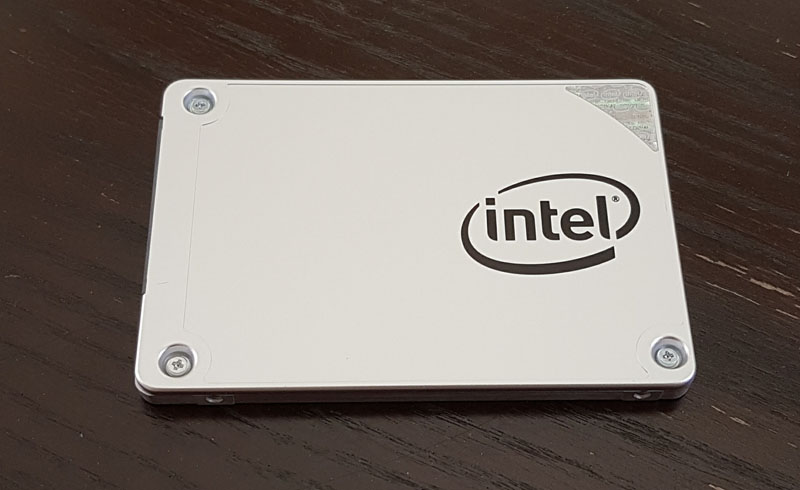The Intel DC S3100 240GB SSD is set to become your next boot drive, or will it? Lately, the STH lab has been overrun by NVMe. In the past few months, we have added over 200TB of NVMe drives for the various demo units we host in DemoEval. The game is already over for SATA in the performance space. NVMe SSDs are several times faster and are already less expensive than their SATA counterparts. Intel’s new S3100 series utilizes TLC NAND and has very low performance and write endurance figures. The purpose of these drives is clear: minimize costs. We did not see any reviews published on the drives so we purchased one.
The Test SSD
Our test SSD was not furnished by Intel. Instead, we purchased it for $102 on Amazon (prices change all the time.)
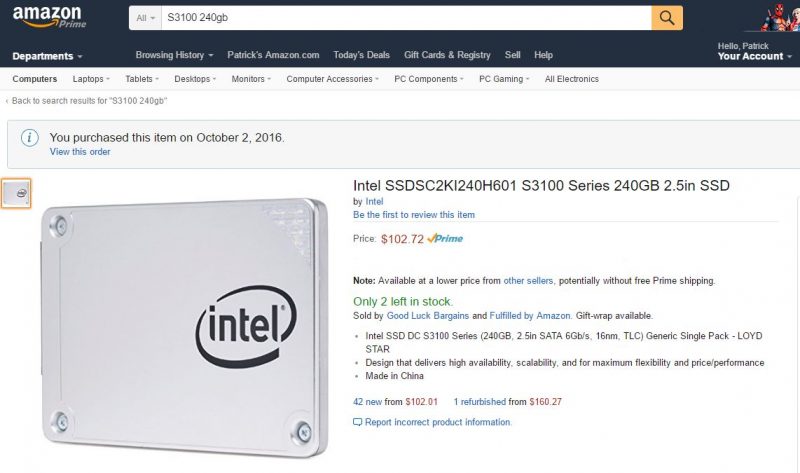
Two days later, we had the drive in hand ready for testing.
Intel DC S3100 240GB Specs
Specs of the drive tell us a lot about what the intended use cases are for the drive. Here is a link to Intel ARK for the drive. We wanted to call attention to a few key specs (current per ARK as of October 18, 2016.)
- Write endurance: 72TBW
- Enhanced Power Loss Data Protection: No
- End-to-End Data Protection: No
- MTBF: 1.6 Million Hours
- UBER: 1 bit Error in 10^16
- Sequential Read: 535 MB/s
- Sequential Write: 106 MB/s
- Random Read: 54000 IOPS
- Random Write: 4400 IOPS
72TBW is very low for a SSD. Although it is twice what our Samsung 750 EVO 120GB drives offer, the same drives we are performing a write endurance test on in Project Kenko 01, it is still anemic compared to normal figures. It works out to around 300 full drive writes over the life of the drive. While we see most data center SSDs are sub 1 or 0.3 drive writes per day (DWPD) these SSDs are essentially rated for around 0.1 DWPD. There is no power loss protection for in-flight data. The 1.6M hour MTBF is well below a common 2M hour MTBF on data center SSDs and many are adopting 2.5M hour ratings now. Finally, the UBER rate of 1 in 10^16 is significantly higher than the 1 in 10^17 or better we are accustomed to with data center SSDs. Looking at the Intel product brief endurance is listed as:
0.1 DWPD for 3 years, warrantied for five years with 72 TBW or E9=1
Looking at performance, these are clearly read-optimized SSDs. The sequential write figure of 106MB/s and random read 4400 IOPS is anemic and is below some modern USB 3.0 flash drives. Read performance is at least decent so we can see where Intel is targeting its drives.
With the Intel DC S3100 240GB we have a drive that has all around poor write specs. We wanted to see if, indeed, the performance was that bad. We are taking a different lens to this review and assuming that these are going to be used as boot drives where the write performance is of significantly less consequence.
As a reference, here is a comparison to the Intel DC S3520 which costs around 40% more per GB.
Positioning the Intel DC S3100 Series
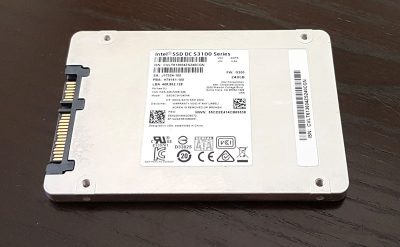
At this point, we wanted to pause. We have an Intel “data center” series drive with sub-par endurance, MTBF, and UBER rates. There is no power loss protection, a hallmark of Intel DC SSDs (and many of their consumer drives.) STH readers are probably wondering, what is going on here?
Our theory on these drives is that these are not meant to be a long-term DC series. Instead, it is likely that they are drives that had a large emerging market opportunity where cost was the absolute most important factor. We suspect that there is a customer or customer class in emerging markets with read heavy workloads still serviced by disks. The Intel DC S3100 may make sense as a competitive response for Intel to replace hard drives in an emerging market while warming that market to the idea that data center SSDs not consumer SSDs belong in servers.
Call this “educated speculation” as Intel did not confirm the above but we did a little digging and think the storyline is not too far from the reality. We also do not expect the Intel DC S3100 series to be a long-lived series as the company will try to transition customers to the S3520 and successor lines. The Intel DC S3500 series is a well regarded and popular product line for Intel and one that STH uses extensively. Intel takes great pride in its data center reliability claims and there is a good chance that having no-PLP, low MTBF and high UBER rate DC SSDs in the mix will hurt the overall product portfolio claims. In fact, we are a bit surprised that Intel did not create a separate brand for the DC S3100 so that it could sell the drives without impacting overall portfolio reliability figures.
Intel DC S3100 240GB Benchmarks
We are not going to run our full Iometer benchmarking suite on these drives. They are not meant for heavy write workloads. Instead, we are going to focus on read workloads that may be experienced if the SSD is used as a boot SSD or simply to store data to be read later. Finding a comparison group was slightly difficult so we decided to use SSDs that were many years old. Most of the new SSDs we are testing are of larger capacities so we had to go back in time to find smaller and slower SSDs for comparison.
AS SSD Benchmark
Our first quick benchmark is AS SSD.
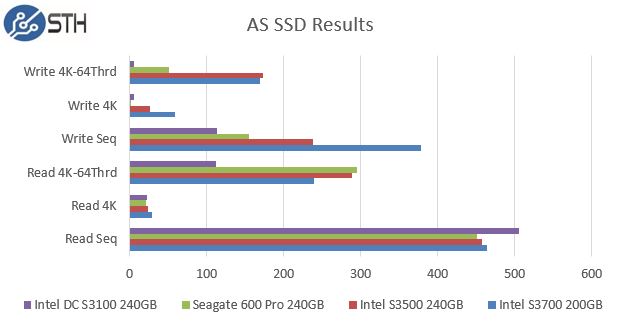
As you can see, the 4K write figures are meager, even compared to older generation SSDs.
CrystalDiskMark Benchmark
Our second quick benchmark is CrystalDiskMark.
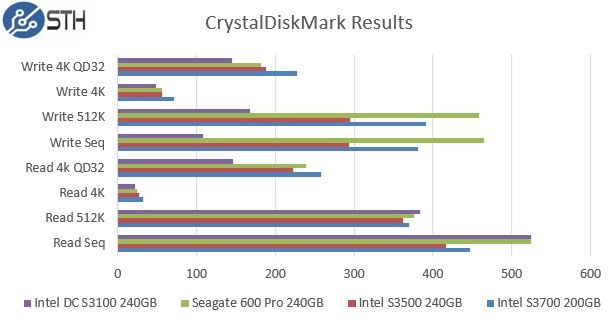
Again we can see that performance of this new drive on the read side is competitive with other data center drives. On the write side, the performance is lower.
ATTO Benchmark
Finally, we move to a more sequential workload with ATTO. Here is the read benchmark comparison.
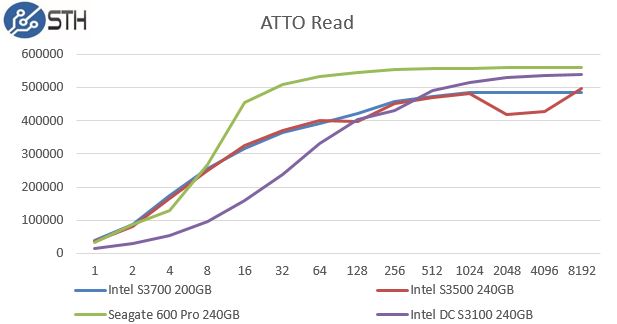
And the write benchmark comparison.
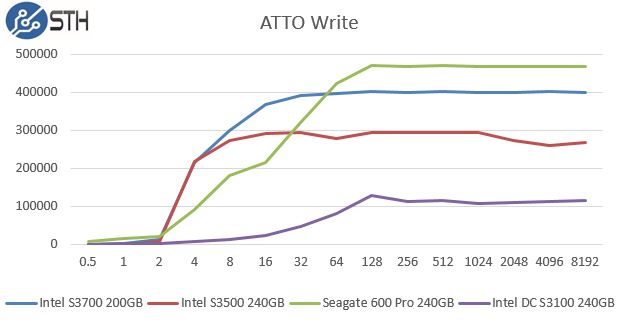
Overall, the read performance is ok while the write performance is an area that the Intel DC S3100 240GB struggles. If you were thinking of replacing legacy hard drives in a read intensive appliaction, these may be a decent option.
Final Words
At the end of the day, these can only tenuously be called “data center” products. Realistically, the Intel DC S3100 drives are ultra low-end consumer SSDs that sacrifice standard data center features for cutting costs. These drives have been rebranded as data center products likely to win a deal in a highly-competitive emerging market. For our money, the Intel DC S3520 is a much better option with only a slight price premium. That is likely why we are not seeing many design wins in the US market. Prior to getting these drives in-house we thought Intel had made a boot drive specific device. That is going to make more sense as all-flash arrays move to NVMe storage and utilizing SATA ports will be needed to save PCIe lanes. If you browse our buyer’s guides, you will see that we do highly recommend Intel SSDs and we use many of them in our own infrastructure. Unfortunately, our experience with the Intel DC S3100 240GB leads us to not recommend these SSDs unless you want the branding of a data center drive while receiving the feature set of a low-cost consumer drive.

